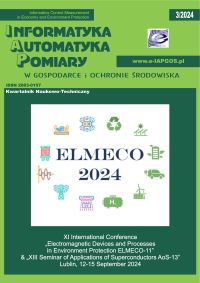ANALIZA NUMERYCZNA ZABIEGU SZTUCZNEJ HIPERTERMII
Łukasz Turchan
lukasz.turchan@polsl.plPolitechnika Śląska w Gliwicach (Polska)
Ewa Majchrzak
Politechnika Śląska w Gliwicach (Polska)
Abstrakt
Artykuł dotyczy numerycznego modelowania zabiegu sztucznej hipertermii. Analiza skuteczności zabiegu jest rozpatrywana nie tylko na podstawie czasoprzestrzennych rozkładów temperatury, ale także w oparciu o parametr dawki termicznej. Do modelowania przepływu ciepła w rozpatrywanym obszarze wykorzystano uogólnione równanie z dwoma czasami opóźnień. Na potrzeby obliczeń numerycznych napisano autorski program oparty o obliczenia równoległe.
Słowa kluczowe:
sztuczna hipertermia, metoda różnic skończonych, obliczenia równoległe, uogólnione równanie z dwoma czasami opóźnieńBibliografia
Afrin N., Zhang Y., Chen J.K.: Thermal lagging in living biological tissue based on nonequilibrium heat transfer between tissue, arterial and venous bloods, International Journal of Heat and Mass Transfer, 2011, 54, pp. 2419–2426.
Google Scholar
Cattaneo C.: A form of heat conduction equation which eliminates the paradox of instantaneous propagation, Comp. Rend., 1958, 247, pp. 431-433.
Google Scholar
Ciesielski M.: Mochnacki B., Numerical analysis of interactions between skin surface temperature and burn wound shape, Scientific Research of Institute of Mathematics and Computer Science, 2012, 1(11), pp. 15-22.
Google Scholar
Khaled A.R.A., Vafai K.: The role of porous media in modeling flow and heat transfer in biological tissues, International Journal of Heat and Mass Transfer, 2003, 46, pp. 4989–5003.
Google Scholar
Kirk D.B., Wen-mei W. Hwu: Programming Massively Parallel Processors, Second Edition: A Hands-on Approach, Morgan Kaufmann, 2012.
Google Scholar
Majchrzak E.: Numerical modelling of bio-heat transfer using the boundary element method, Journal of Theoretical and Applied Mechanics, 1998, 2(36), pp. 437-455.
Google Scholar
Majchrzak E.: Mochnacki B.: Numerical methods. Theoretical bases, practical aspects and algorithms, Publ. of the Silesian University of Technology, Gliwice, Poland, 2004.
Google Scholar
Majchrzak E., Poteralska J.: Turchan Ł,: Comparison of different bioheat transfer models used in numerical modelling of a hyperthermia therapy, International Conference of the Polish Society of Biomechanics “Biomechanics 2010”, Book of Abstracts, Warsaw, Poland, 2010, pp. 137-138.
Google Scholar
Majchrzak E., Turchan L.: Numerical modeling of a hyperthermia therapy using dual-phase-lag model of bioheat transfer, 19th International Conference on Computer Methods in Mechanics CMM 2011, Short Papers, Warsaw, Poland, 2011, pp. 337-338.
Google Scholar
Minkowycz, W.J., Haji-Sheikh, A., Vafai, K.: On departure from local thermal equilibrium in porous media due to a rapidly changing heat source: the Sparrow number, Int. J. Heat Mass Transfer, 42, 1999, pp. 3373-3385.
Google Scholar
Nakayama A., Kuwahara F.: A general bioheat transfer model based on the theory of porous media, International Journal of Heat and Mass Transfer, 51, 2008, pp. 3190–3199.
Google Scholar
Peng T., O’Neill D.P., Payne S.J.: A two-equation coupled system for determination of liver tissue temperature during thermal ablation, International Journal of Heat and Mass Transfer, 54, 2011, pp. 2100-2109.
Google Scholar
Wen-mei W. Hwu: GPU Computing Gems Emerald Edition, Morgan Kaufmann, 2011.
Google Scholar
Yuan, P.: Numerical analysis of temperature and thermal dose response of biological tissues to thermal non-equilibrium during hyperthermia therapy– Medical Engineering & Physics, 2008, 20, pp. 135-143.
Google Scholar
Autorzy
Ewa MajchrzakPolitechnika Śląska w Gliwicach Polska
Statystyki
Abstract views: 150PDF downloads: 57
Licencja

Utwór dostępny jest na licencji Creative Commons Uznanie autorstwa – Na tych samych warunkach 4.0 Miedzynarodowe.








